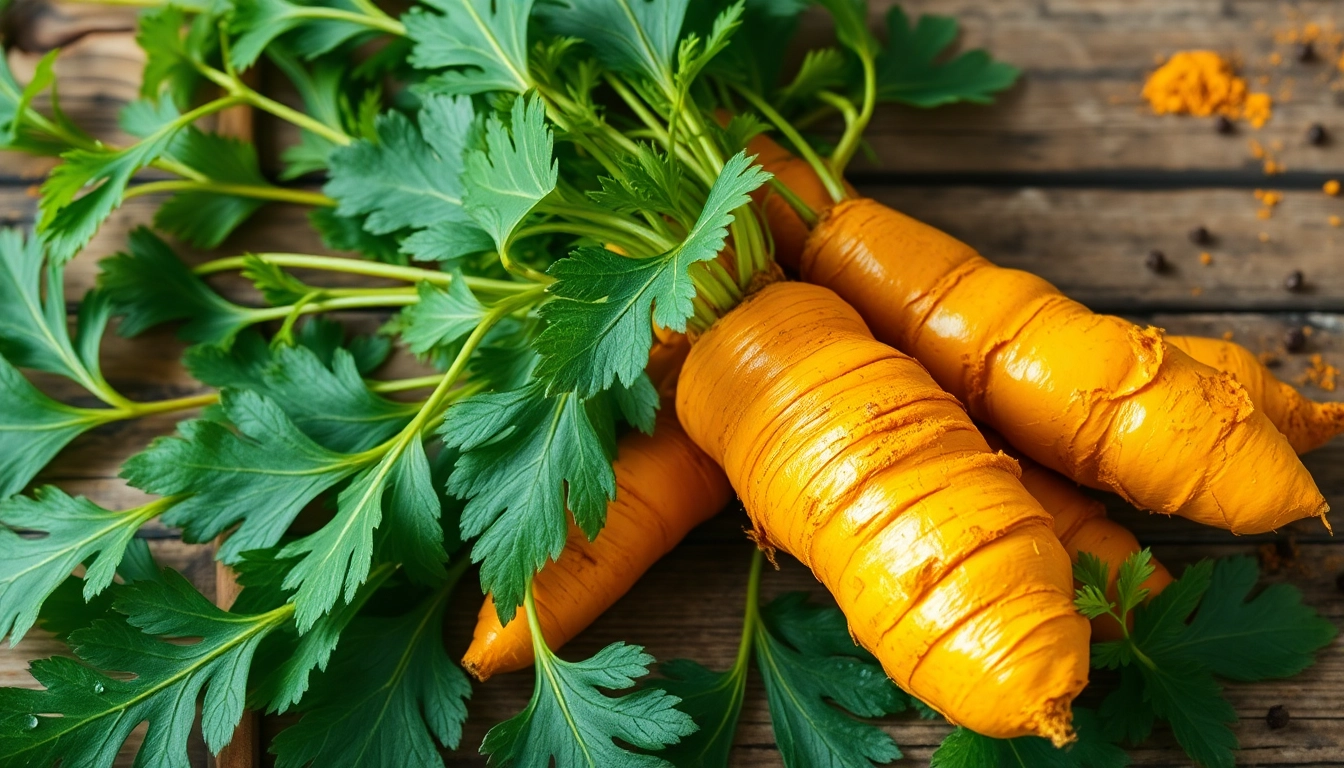Understanding Turmeric Root
What is Turmeric Root?
Turmeric root, known scientifically as Curcuma longa, is a vibrant orange-yellow rhizome that belongs to the ginger family. This versatile root is widely acclaimed for its culinary, medicinal, and health-enhancing properties. Growing primarily in tropical and subtropical regions of Asia, turmeric has a long history of use in Indian cooking, traditional medicine, and spiritual practices. It has a warm, peppery flavor and is often ground into a fine powder for easy incorporation into various dishes and products.
This rhizome has been a staple in kitchens around the world, and its distinct flavor enhances everything from curries to smoothies. Notably, Turmeric Root is not just a culinary delight but serves as a potent natural remedy.
The Historical Significance of Turmeric in Medicine
Historically, turmeric has been recognized for its medicinal properties dating back over 4,000 years. In Ayurvedic medicine, it has been utilized to treat a variety of health conditions, including inflammation, digestive disorders, and skin issues. Ancient texts mention the use of turmeric in healing rituals, highlighting its cultural significance beyond mere culinary applications. In traditional Chinese medicine, turmeric was valued for its ability to promote blood circulation and relieve pain.
Common Varieties of Turmeric Root
While there are numerous varieties of turmeric, the most commonly used type is the Curcuma longa. Other notable varieties include:
- Curcuma aromatica: Known for its aromatic properties but less common in culinary use.
- Curcuma zedoaria: Also known as white turmeric, it has a slightly different taste and is often used in certain Southeast Asian cuisines.
These varieties differ in flavor, aroma, and potential health benefits, but all share the characteristic golden color and beneficial properties that turmeric is famed for.
Health Benefits of Turmeric Root
Anti-Inflammatory Properties
One of the most significant health benefits of turmeric root is its potent anti-inflammatory effects. Curcumin, the primary active ingredient in turmeric, has been extensively researched for its ability to reduce inflammation at the molecular level. Studies indicate that curcumin influences various inflammatory pathways, effectively reducing inflammatory markers in the body.
This property makes turmeric a potential remedy for chronic conditions, such as arthritis, heart disease, and even certain cancers. For individuals suffering from chronic pain and inflammation, incorporating turmeric into their diet may provide significant relief.
Turmeric Root as an Antioxidant
In addition to its anti-inflammatory properties, turmeric root is a powerful antioxidant. Antioxidants play a critical role in neutralizing free radicals—unstable molecules that can cause cell damage and contribute to aging and disease. Curcumin enhances the body’s antioxidant capacity, which can help combat oxidative stress.
Research shows that individuals who consume turmeric regularly often experience lower levels of oxidative stress and, subsequently, a reduced risk of age-related diseases. This makes turmeric a valuable addition to a health-conscious diet aimed at promoting longevity and wellness.
Potential Benefits for Digestive Health
Turmeric root has been used traditionally to aid digestion and improve gut health. It is thought to stimulate the production of bile, which plays a vital role in breaking down fats and enhancing nutrient absorption. Furthermore, turmeric’s anti-inflammatory properties can soothe the gut lining, providing relief for conditions such as irritable bowel syndrome (IBS) and inflammatory bowel diseases (IBD).
For those looking to promote gut health, incorporating fresh turmeric root or turmeric powder into their meals may encourage healthier digestive function.
How to Use Turmeric Root in Your Diet
Fresh Turmeric Root Recipes
Fresh turmeric root is a versatile ingredient that can be used in various recipes. Here are some simple ways to incorporate turmeric into your meals:
- Turmeric Tea: Simmer sliced fresh turmeric in water, strain, and sweeten with honey for a soothing drink.
- Curries and Stir-Fries: Add grated turmeric root to your favorite stir-fry or curry for an earthy flavor and vibrant color.
- Soups: Puree fresh turmeric into soups for added warmth and nutritional benefits.
Experimenting with fresh turmeric root can introduce unique flavors to a variety of dishes while providing a health boost.
Incorporating Turmeric into Smoothies
Smoothies are an excellent way to incorporate turmeric root into your diet. The pungent, spicy flavor of turmeric pairs well with fruits like bananas, mangoes, and oranges. Here’s a quick recipe for a tasty and nutritious turmeric smoothie:
- Combine 1 banana, 1 cup of spinach, 1 teaspoon of grated fresh turmeric, and 1 cup of almond milk in a blender.
- Add a pinch of black pepper to enhance curcumin absorption.
- Blend until smooth and enjoy!
This smoothie not only tastes great but also packs a powerful punch of nutrients to kickstart your day.
Best Practices for Cooking with Turmeric
When cooking with turmeric, a few best practices can help maximize its health benefits:
- Use Fresh Ingredients: Opt for fresh turmeric if possible, as it is more potent and flavorful than dried turmeric powder.
- Pair with Black Pepper: Adding black pepper to dishes made with turmeric enhances curcumin absorption significantly, making the health benefits even more pronounced.
- Cook with Fat: Since curcumin is fat-soluble, incorporating healthy fats like olive oil or coconut oil can help increase its bioavailability.
Following these practices can ensure you’re reaping the maximum rewards from this incredible root.
Side Effects and Precautions
Possible Interactions with Medications
While turmeric root is generally safe for consumption, it can interact with certain medications. For example, turmeric can enhance the effects of blood thinners, potentially leading to an increased risk of bleeding. Additionally, it may affect the absorption of medications metabolized in the liver, such as some antidepressants and cancer treatments.
It is crucial for individuals considering turmeric supplements or large amounts of the root to consult with healthcare professionals, especially if they are on medication.
Allergic Reactions and Sensitivities
Some people may experience allergic reactions to turmeric root, ranging from mild skin irritations to more serious symptoms. Anyone with a known allergy to ginger should approach turmeric with caution. It is advisable to start with small doses and monitor any adverse reactions.
Recommended Dosage for Supplements
If using turmeric root in supplement form, following the recommended dosages is essential for safety. Generally, doses of curcumin extract often range from 500 to 2000 mg per day. However, the appropriate dosage can depend on individual health conditions and goals, hence discussing with a healthcare provider is advised.
Purchasing and Storing Turmeric Root
Where to Buy Quality Turmeric Root
Quality is key when selecting turmeric root. It can be found at most grocery stores, health food shops, and online retailers. When purchasing, look for fresh, firm roots that are free from blemishes. For powdered turmeric, choose organic options without additives to ensure maximum health benefits. Well-known suppliers, such as Whole Foods Market, offer quality turmeric products.
Storage Tips for Fresh Turmeric
Proper storage can extend the shelf life of fresh turmeric. To store fresh turmeric, wrap it in a paper towel and place it in a sealed bag in the refrigerator. It can last for up to a couple of weeks this way. Dried turmeric root should be kept in a cool, dark place, away from moisture, to maintain its potency.
Choosing Between Fresh and Powdered Forms
Both fresh and powdered turmeric have their advantages. Fresh turmeric offers a more vibrant flavor and higher potency, while powdered turmeric is more convenient and has a longer shelf life. For optimal health benefits, using a combination of both in your diet can cater to diverse culinary applications and ensure you’re not missing out on potential health benefits.



